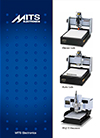FP-21T Precision Introduction Example
Using MITS FP-21T Precision milling machine at the University
of Belgrade
Introduction
process
The FP-21T Precision milling machine was purchased
from a grant of the Serbian Ministry of Science and
Technological Development. The grant was given to
the Group for Electromagnetics, Antennas, and Microwaves
at the School of Electrical Engineering. For about
half a century, the Group has been one of the world
leaders in the theoretical research, computational
techniques, and engineering development. The group
has 10 full-time faculty members, who cover teaching
at the bachelor, master, and Ph.D. levels. At all
three levels, there are curricula dedicated to microwave
engineering and the total number of enrolled students
is about 120 (out of about 3000 at the whole School
of Electrical Engineering).
According to the rules set by the Ministry, all research
and academic institutions in Serbia have access to
the machine. In particular, we expect the machine
to be heavily utilized by the staff of the Microwave
Institute in Belgrade, which is involved in the design
and production of microwave and millimeter wave devices.
Getting started with the machine was facilitated by
the training obtained from MITS in October 2008. It
was followed by a period of a few weeks of self-training.
As the result, we now feel confident to be able to
produce even tricky printed patterns.
We have to emphasize the good support obtained from
MITS, whose staff is always ready to help, answer
any question we may have, and promptly improve software
and manuals wherever appropriate.
|
|
|
FP-21T Precision enables resolution below 0.1 mm
The FP-21T Precision machine has an important role both
in the teaching and research activities of our group. The
machine enables rapid experimental verification of the design
of microwave devices and, in particular, millimeter-wave
devices.
The target substrate is in most cases a Teflon-based laminate,
Rogers 4003 or a similar substrate. Some high-frequency
circuits (e.g., filters) require very narrow gaps between
microstrip traces.
Before purchasing the FP-21T Precision machine, our PCBs
were produced by etching. The standard resolution of the
available etching technology is 0.2 mm.
With particular care and manual processing, the resolution
could be pushed down to nearly 0.1 mm, but with low yield.
However, the FP-21T Precision machine has enabled easy
manufacturing with resolution below 0.1 mm.
We have successfully milled patterns with 0.05 mm resolution
and we have been investigating possibilities even to push
this limit further.
The new technology, which we have mastered owing to the
FP-21T Precision machine, enabled production of filters
with wider bandwidth than we could produce by etching and
facilitated production of devices for the millimeter-wave
range. Although we have been using the machine for only
3 months, we have already made several wideband coupled-resonator
filters. |
A significant step-up in PCB quality and fast turn-around
time
Besides achieving a significant step-up in the quality of
manufacturing of microwave printed-circuit boards, we have
attained fast turn-around time, which is necessary for the
development of laboratory prototypes. Instead of outsourcing
the PCB manufacturing, we can now quickly get prototypes,
even in the evening and on weekends, which is important
in the research activities of both the faculty members and
Ph.D. students. |
Sharp edges obtained with suitable tools
The milling process should be carefully implemented.
Microwave milling tools are of great help not only to obtain
vertical metallization walls, but also to accurately control
the width of conductors (strips, traces) and gaps.
Incremental milling helps to obtain
clean conductor edges.
Conical tools leave sloped conductors walls, with sharp
and clean edges.
However, good control of the tool depth is necessary to
maintain the necessary precision of patterns.
|
Capable of designing microwave circuit with large copper
leftover surfaces
Besides using the milling machine for efficient prototyping,
the milling process has motivated us to undertake research
activities aimed at obtaining accurate models of milled
microwave circuits and also at speeding up the milling process
by leaving large copper areas intact (rather than rubbing
them out).
These large areas are coupled to the microwave circuit and
they have a twofold influence. The first influence is modification
of the characteristic impedances of traces in a broad frequency
range. The second influence is caused by parasitic resonances
of the copper areas. In our research, we have performed
computer simulations, followed by experimental verification,
which have given us sufficient information to be able to
keep both influences under full control.
Hence, we are capable of designing microwave circuits with
large copper leftover surfaces, keeping intact the circuit
performance.
In conclusion, the FP-21T Precision milling machine has
given us a significant technology boost which is of great
help in our teaching, research, and design activities.
Professor Dr. Antonije Djordjevic
University of Belgrade
School of Electrical Engineering
Serbia
Read more>>
Computer-aided modeling
and design of printed-circuit boards fabricated using MITS
FP-21T Precision milling machine |
|
MITS
General Catalog

English
(PDF file / 1.8MB)
MITS Electronics
E-MAIL

Contact us : Inquiry Form
|

